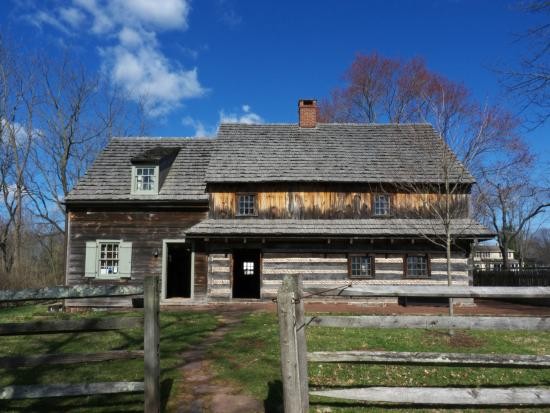Morgan Log House
Introduction
Text-to-speech Audio
Images
Morgan Log House from Weikel Road

A sketch by "Sis" Forsythe Robinson of the Morgan Log House property, between 1933 and 1936.

Backstory and Context
Text-to-speech Audio
The families that lived in the Morgan Log House were working class people who left behind very few written records. As a result, much of what we know about the Morgan Log House was gleaned through deed research, other documents like censuses and probate records, and the house itself.
A Farm Home
The land the Morgan Log House stands on was originally deeded to the Commissioners of William Penn, who granted it as part of a 600 acre patent to a merchant named Griffith Jones in February, 1702. Six year later, in 1708, a Welsh Quaker immigrant named Edward Morgan purchased approximately 309 acres of land from Griffith Jones. Morgan and his family became the first settlers of the property. The Morgan family was among the earliest Welsh settlers in the Towamencin area. Among the descendants of Edward Morgan and his wife Elizabeth are the frontiersman Daniel Boone, journalist and broadcaster Lowell Thomas, and mutual fund industry pioneer, Walter L. Morgan.
The property later became under John Yaekel's ownership, a German Schwenkfelder, in 1770. Yaekel built the existing log house sometime between 1770 and 1774. After having made these “fair improvements,” Yaekel sold the property and the log house to Yellis Cassel, and his family, a Mennonite family who were known pacifists during the American Revolution. The Cassel family owned the property for 99 years. After a succession of owners and property divisions, the remaining 17 acres of property were sold to be developed in 1965, with the then abandoned log house being condemned two years later. Throughout its functional life, the house had always been a part of a farm that was worked by the families that lived there.
The Restoration
Architect Albert F. Ruthrauff asserted that the property was a unique historic structure in 1967, as the building sat condemned. The house was brought to the attention of historic restoration architect G. Edwin Brumbaugh and the Towamencin Township Board of Supervisors. Supervisor John B. Jacobs spearheaded a movement to save the house from demolition. A non profit organization, the Towamencin Historical Society (now the Morgan Log House), formed during the restoration and began research on the home and its occupants. Restoration was completed in 1976, with the house opening to the public for tours that same year.
The Morgan Log House Today
In 1973, the Morgan Log House was added to the National Register of Historic Places.
Today, the Morgan Log House continues to bring the past to life through tours, programs, and workshops that educate the public about how the lives of those living in the Morgan Log House and throughout the region illuminate to the broader American story.
Cite This Entry
Morgan Log House, . "Morgan Log House." Clio: Your Guide to History. March 18, 2021. Accessed March 14, 2025. https://theclio.com/tour/1802/2
Sources
History of the Property and House. Morgan Log House. Accessed February 14, 2021. http://www.morganloghouse.org/history-2/.
Oral History of Sis Forsythe Robinson. Morgan Log House files.

